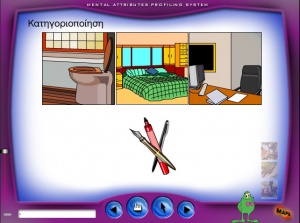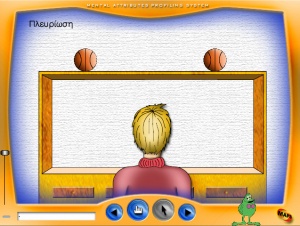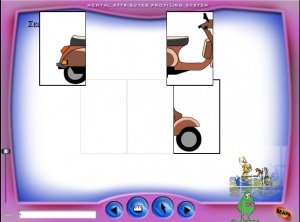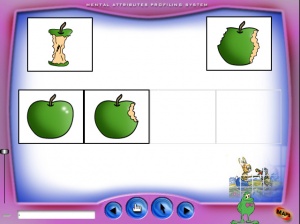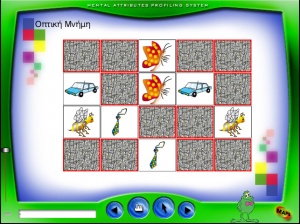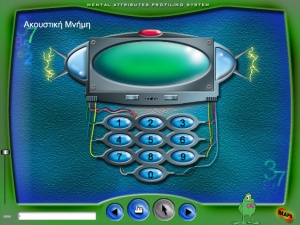Mental Attributes Profiling System: Difference between revisions
No edit summary |
No edit summary |
||
| Line 20: | Line 20: | ||
The MAPS (Mental Attributes Profiling System) cognitive test is a battery of more than 12 validated computer-based video-game-like tests that assess the learning abilities of pre-elementary and elementary age school children. The non-verbal group consists of language-independent tests. Snap shots of three tests are shown in the figures below. | The MAPS (Mental Attributes Profiling System) cognitive test is a battery of more than 12 validated computer-based video-game-like tests that assess the learning abilities of pre-elementary and elementary age school children. The non-verbal group consists of language-independent tests. Snap shots of three tests are shown in the figures below. | ||
The following eight tests have been used for the multimodal evaluation reported here:</ul> | |||
| Line 45: | Line 44: | ||
[[File:Navigation.jpg|left|thumb|upright=1|alt=Logo.|Ability to navigate]] | [[File:Navigation.jpg|left|thumb|upright=1|alt=Logo.|Ability to navigate]] | ||
The Navigation test consists of an 8x8 matrix of small pieces of cheese and a mouse. The computer instructs the subject to move the mouse in one of eight possible directions to “eat” the corresponding piece of cheese: Up, Right-up, Right, Right-Down, Down, Left-down, Left, and Left-up. The instructions are given both visually (with the aid of a small arrow) and/or orally. For the tests reported here the instructions were given only orally. The software measured the total number of correct responses and the total number of correct responses divided by total number of trials. | The Navigation test consists of an 8x8 matrix of small pieces of cheese and a mouse. The computer instructs the subject to move the mouse in one of eight possible directions to “eat” the corresponding piece of cheese: Up, Right-up, Right, Right-Down, Down, Left-down, Left, and Left-up. The instructions are given both visually (with the aid of a small arrow) and/or orally. For the tests reported here the instructions were given only orally. The software measured the total number of correct responses and the total number of correct responses divided by total number of trials. | ||
| Line 58: | Line 50: | ||
[[File:Sequencg2.jpg|right|thumb|upright=1|alt=Logo.|Sequencing of 'broken' events]] | [[File:Sequencg2.jpg|right|thumb|upright=1|alt=Logo.|Sequencing of 'broken' events]] | ||
This test was inspired by the “connect the puzzle” games. Different objects or animals appear in two-, three-, four-, or five pieces and the subject is requested to “drag” the pieces and place them in the right order to complete the picture. The second part of the test presents pictures, which represent different stages of a temporal process. The subject is expected to put them in the correct chronological order. The test measured the total time required to complete each sub-section of the test (the test was comprised of six different types of exercises divided by six (i.e., (stt1+stt2+...stt6)/6 in Tabl.1). | This test was inspired by the “connect the puzzle” games. Different objects or animals appear in two-, three-, four-, or five pieces and the subject is requested to “drag” the pieces and place them in the right order to complete the picture. The second part of the test presents pictures, which represent different stages of a temporal process. The subject is expected to put them in the correct chronological order. The test measured the total time required to complete each sub-section of the test (the test was comprised of six different types of exercises divided by six (i.e., (stt1+stt2+...stt6)/6 in Tabl.1). | ||
| Line 73: | Line 59: | ||
For the purpose of preliminary studies, only VMtt: Total time to complete the test, and VMnoT: Total number of trials, were used. | For the purpose of preliminary studies, only VMtt: Total time to complete the test, and VMnoT: Total number of trials, were used. | ||
| Line 90: | Line 70: | ||
* AMTc: Total number of correct responses | * AMTc: Total number of correct responses | ||
* AMTcw: weighted number of correct digits (i.e., all correctly types digits even when the sequence was wrong) were used as measures of auditory digit span. | * AMTcw: weighted number of correct digits (i.e., all correctly types digits even when the sequence was wrong) were used as measures of auditory digit span. | ||
Revision as of 04:24, 25 February 2013
|
The Mental Attributes Profiling System (MAPS) is a language independent screening test, i.e., relies on cognitive rather than language-based measures, capable of predicting children at risk (possible dyslexics) and equipping teachers with a profile of their mental abilities so as to design personalized remediation programs.
The MAPS (Mental Attributes Profiling System) cognitive test is a battery of more than 12 validated computer-based video-game-like tests that assess the learning abilities of pre-elementary and elementary age school children. The non-verbal group consists of language-independent tests. Snap shots of three tests are shown in the figures below.
The following eight tests have been used for the multimodal evaluation reported here:
Categorization
The test presents an object on the lower part of the screen and invites the subject to “drag” it in one of three squares that represent different “worlds,” for which there is a match.
The following “categories” were tested:
- Objects of different color to be placed in one of three possible “colored worlds,” i.e., squares of three different colors;
- One geometrical object, (i.e., triangular, circular, or rectangular), to be placed in its corresponding world, i.e., the squares contained triangular, circular or rectangular shapes respectively;
- A plant matched as a vegetable, a tree, or a flower;
- An animal (or fish) to be placed in one of three possible environments: sea, sky, or open fields;
- Objects usually found in a home environment, to be “placed” in one of three rooms of a house (office, kitchen, or bathroom), i.e., as in the example snapshot shown in the illustration. The software measured the time to response and whether the move was correct or false. For this study we used only the average response time (i.e., the cumulative response time of each test divided by 5: (ctt1+ctt2+...ctt5)/5 in Table 1), as it has been shown previously to have a higher correlation than the Correct/False values.
Orientation: “Left-Right Game” Lateral awareness Test
This test provides two types of measures. One, it evaluates the child’s ability to make left-right discriminations on his own body. During the first part, the test shows a child “sitting” in the same orientation as the subject (i.e., the subject sees on the screen the back of the child) in front of two objects, one on his/her upper left and the other on his/her upper right visual field. The computer asks the subject to “grab” the left or right object using his/her left or right hand. What is measured is (1) the time taken to select an arm (by clicking at the shoulder), and (2) whether the selected arm was correct or wrong. The same procedure is repeated during the second part of the test, in which the orientation of the child on the screen is reversed, i.e., the child on the screen is facing the subject. The second type of measures are derived from Piaget’s (19) tests to evaluate awareness of right-left relations outside our own body, i.e., in the environment. To evaluate this ability, the test measures (1) the time taken by the subject to decide which object to “grab” and (2) the number of correct/wrong decisions.
The Navigation test consists of an 8x8 matrix of small pieces of cheese and a mouse. The computer instructs the subject to move the mouse in one of eight possible directions to “eat” the corresponding piece of cheese: Up, Right-up, Right, Right-Down, Down, Left-down, Left, and Left-up. The instructions are given both visually (with the aid of a small arrow) and/or orally. For the tests reported here the instructions were given only orally. The software measured the total number of correct responses and the total number of correct responses divided by total number of trials.
Sequencing
This test was inspired by the “connect the puzzle” games. Different objects or animals appear in two-, three-, four-, or five pieces and the subject is requested to “drag” the pieces and place them in the right order to complete the picture. The second part of the test presents pictures, which represent different stages of a temporal process. The subject is expected to put them in the correct chronological order. The test measured the total time required to complete each sub-section of the test (the test was comprised of six different types of exercises divided by six (i.e., (stt1+stt2+...stt6)/6 in Tabl.1).
Visual memory
This test is based on the well-known card game called “Memory,” in which the subject uncovers two cards at a time. If the two cards featured the same picture, they would remain uncovered and thus visible. Otherwise they are turned back as they were, and the game continues until all cards are uncovered.
The test keeps records of many parameters, including the number of iterations that have passed since the subject “saw” a certain card.
For the purpose of preliminary studies, only VMtt: Total time to complete the test, and VMnoT: Total number of trials, were used.
Auditory memory
The test was modeled using the digital phone metaphor. The computer instructor invites the subject to “dial” a telephone number. Two sets of two-digit numbers are followed by four sets of three-, four-, five-, and six digit numbers, respectively.
The test concludes by presenting a set of two seven-digit numbers. The feedback is positive/neutral giving no clue regarding the correctness of the response. The test is terminated if the subject makes 3 consecutive errors.
For the purposes of the preliminary analysis only the following parameters were considered:
- AMTc: Total number of correct responses
- AMTcw: weighted number of correct digits (i.e., all correctly types digits even when the sequence was wrong) were used as measures of auditory digit span.
Auditory discrimination test
The main screen of the test features two human-like figures, who “speak” a word, one after the other. The subject is asked to decide whether the two words are the same or different by clicking on an “” or a “•” sign. Each word includes consonants, which sound similar and are therefore confused by weak readers and especially by dyslexics in the Greek language.
The following letter combinations were tested:
- φ-β
- δ-θ
- ζ-σ
- χ-γ
- τ-ντ
- κ-γγ/γκ
- π-μπ
- τσ-στ
- γ-γγ/γκ
- ξ-κς.
In additional sets, the test also evaluates the ability of the child to differentiate between the same letter combinations when they are embedded in non-sense words. The test kept record of the time and correctness of each instance. In Tabl.1 adtt(1), adtt(2),...adtt(n) are used to denote the time taken to respond to each card presented.
Visual discrimination
Modeled using the popular “Find the differences” game, this test presents three pictures very similar to one another and one that must be matched. The exercise is repeated four times with four different pictures. The total number of correct responses is used as an index of visual discrimination.
Publications
- Loizou, A., & Laouris, Y. (2011). Developing prognosis tools to identify learning difficulties in children using Machine Learning technologies. Cognitive Computation, DOI 10.1007/s12559-010-9052-5.
- Laouris, Y., Aristodemou, E., and Makris, P. (2009). Prediction of Learning Abilities Based on a Cross-Modal Evaluation of Non-verbal Mental Attributes Using Video-Game-Like Interfaces. In Cross-Modal Analysis of Speech, Gestures, Gaze and Facial Expressions: COST Action 2102 international Conference Prague, Czech Republic, October 15-18, 2008 Revised Selected and invited Papers, A. Esposito and R. Vích, Eds. Lecture Notes In Artificial Intelligence, vol. 5641. Springer-Verlag, Berlin, Heidelberg, 248-265. DOI= http://dx.doi.org/10.1007/978-3-642-03320-9_24
- Haddad, C. and Laouris, Y. (2011). The ability of children with mild learning disabilities to encode emotions through facial expressions. In Towards Autonomous, adaptive and context-aware multimodal interfaces: Theoretical and Practical Issues. A. Esposito, Esposito, A.M., Martone, R., Müller, V.C., Scarpetta, G (Eds.): COST 2102 Int. Training School 2010, Lecture Notes In Artificial Intelligence Springer-Verlag, Berlin, Heidelberg 6456, 387-402.
- Laouris, Y., Makris, P., Papadopoulos, T. (2011). Validation of MAPS in 16 schools: Computer-based battery of 8 mental attributes tests (in preparation; draft available).
MAPS presented in International Conferences
- Petrou, P., & Laouris, Y. (1999). Διάγνωση, Aξιολόγηση, Aποκατάσταση της ικανότητας προσανατολισμού με τη χρήση H/Y. Mediterranean Computer-Using Educators' Conference, University of Cyprus, Jun 1999, Proceed., p. 00.
- El-Haddad, C., & Laouris, Y. (1999). Measurement and assessment using educational computer interfaces. Mediterranean Computer Using Educators' Conference, University of Cyprus, Jun 1999, Proceed., p. 00.
- Laouris, Y., Makris, P., & Georgiou, G. (2002). MAPS (Mental Attributes Profiling System): A computerized, psychometric system for cognitive analysis. In A. Gagatsis, L. Kyriakides, N. Tsaggaridou, & E. Ftiaka (Eds.), Proceedings of the VII Pancypriot Conference of Educational Research (pp. 225-233), University of Cyprus [In Greek].
- Laouris, Y., & Makris, P. (2002). M.A.P.S. Mental Attributes Profiling System computerized battery for dyslexia assessment. Proc. IDA 53rd Annual Conference, November 13-16, 2002 - Atlanta, Georgia, USA.
- Laouris, Y., & Makris, P. (2002). M.A.P.S. Mental Attributes Profiling System computerized battery for dyslexia assessment. Proc. Multilingual & Cross-Cultural Perspectives on Dyslexia, Omni Shoreham Hotel, Washington, D. C., June 27-29, 2002, USA.
- Papadopoulos, T. C, Laouris, Y., & Makris, P. (2003). The validation of a computerised cognitive battery of tests for the diagnosis of children with dyslexia. Proc. IDA 54th Annual Conference, November 12-15, 2003 – San Diego, California, USA.
- Laouris, Y., Papadopoulos, T. C, & Makris, P. (2004). The validation of MAPS, computerized cognitive battery of tests, in 30 schools of Cyprus. 6th BDA International Conference, March 27-30, 2004 – Warwick, UK.
- Laouris, Y., Papadopoullou, Y. & Gerjets, P. (2005). Ubiquitous adaptation of learning objects to the level of the learner. Proceedings Cost219ter Workshop Accessibility for all. Ayia Napa Cyprus, Oct 7.
- Loredana Mihalca, L., Laouris, Y., Miclea, M. (2007). Children’s school readiness: predicting school competence in first grade. Proc. EARLI Conference, Budapest, Hungary, 26-31 Aug. 2007.
- Laouris, Y., & Makris, P. (2007). An interactive ICT demonstration of MAPS (Mental Attributes Profiling System). Proc. EARLI Conference, Budapest, Hungary, 26-31 Aug. 2007.
- Taraszow, T., Wahl, J., Laouris, Y., Scheiter, K., & Gerjets, P. (2007). Using Dynamic Visualization with Written Explanation to By-Pass Information Processing Deficits of Children with Reading Difficulties. Proc. EARLI Conference, Budapest, Hungary, 26-31 Aug. 2007.
- Taraszow, T., & Laouris, Y. The development of the categorization ability in children age 8 to 12. Proc. EARLI Conference, Budapest, Hungary, 26-31 Aug. 2007.
- Aristodemou, E., Taraszow, T., Laouris, Y., Papadopoulos, T., & Makris, P. (2008). Prediction of Reading Performance Using the MAPS (Mental Attributes Profiling System) Multimodal Interactive ICT Application. Proceedings of 7th European Conference on e-learning, Agia Napa, Cyprus.
MAPS; part of many conferences
MAPS has motivated the organization of a number of local and international conferences:
MAPS Associates
The following people have participated in the inception and first Phase research of the project:
- Yiannis Laouris
- Pantelis Makris
- Despo Minaidou
- Andreas Papapavlou, University of Cyprus
- Athanasios Gagatzis, University of Cyprus
- Chris Singletton, University of Hull
- Costas Apostolides, Cyprus Dyslexia Association
- Christiane El Haddad, Psycholosgist
- Anna Basileiadou-Elissaiou]], Cyprus Dyslexia Association
- Petroula Petrou
- Mira Ioannou
- Maria Papageorgiou
- Margarita H'Anastasi
- Eleni Pavlou
- Miranda Andronikou
- Eleni Constantinidou
- Alexandros Kofteros
- Andreas Savva
- Maria Mavromichali
Validation in Public Schools
The following Elementary School teachers have collaborated with the Cyprus Neuroscience and Technology Institute, the Ministry of Education and the University of Cyprus for the testing of MAPS in 30 public elementary schools between February and June 2003. The results of this validation have been reported at the 54th Annual International Dyslexia Association Annual Meeting.
- Angeliki Charalambous
- Margarita
- Elena Kokkinofta
- Tatiana Koufalidou
- Stelios Hadjiyiannis
- Panayiota Yianni
- Thoi Asvestas
- Tzeni Digigoropoulou
- Lambros Stavrou
- Natalia Tsangarides
- Triada Kyriakou
- Dora Costa Spanashi
- Filanthi Christou Maria Pieri
- Loukia Cosma – Achilleos
- Christina Theophanous
- Maria Petinari
- Tarsi Hadjitheodoulou
- Christina Pieridou
- Elena Georgalidou
- Stelios Stylianou
- Anastasia Georgiadou
- Marina Constantinou
- Antonis Andreou
- Andri Michael
- Stella Ioannides

